DOI:10.32604/iasc.2023.025980

| Intelligent Automation & Soft Computing DOI:10.32604/iasc.2023.025980 |  |
| Article |
Using a Software-Defined Air Interface Algorithm to Improve Service Quality
1Department of ECE, Jawaharlal Nehru Technological University, Ananthapuramu, Telagana, India
2Department of ECE, G. Pulla Reddy Engineering College, Kurnool, A.P., India
*Corresponding Author: Madiraju Sirisha. Email: madiraju.sirisha@gmail.com
Received: 11 December 2021; Accepted: 23 February 2022
Abstract: In the digital era, the Narrowband Internet of Things (Nb-IoT) influences the massive Machine-Type-Communication (mMTC) features to establish secure routing among the 5G/6G mobile networks. It supports global coverage to the low-cost IoT devices distributed in terrestrial networks. Its key traffic characteristics include robust uplink, moderate data rate/device, extremely high energy efficiency, prolonging device lifetime, and Quality of Service (QoS). This paper proposes a Deep Reinforcement Learning (DRL) combined software-defined air interface algorithm applied on the switching system, satisfying the user requirement and enabling them with the network resources to extend quality of service by choosing the most appropriate quality of service metric. In this framework, Non-Orthogonal Multiple Accesses (NOMA) and Rate-Splitting Multiple Access (RSMA) are combined to accommodate massive (Nb-IoT) devices that can be utilized the entire resource (frequency band) for tackling the unknown dynamics prohibitive. The proposed algorithm instantly assigns the network resources per user requirements and enhances selecting the best quality of service metric optimization. Therefore, it has potential benefits of high scalability, low latency, energy efficiency, and spectrum utility.
Keywords: DRL; NOMA-RSMA; nb-IoT; mMTC; QoS
The development of the Internet of Things (IoT) and its related platforms has piqued the attention of both scientists and businesses in the flow of data among IoT endpoints, including servers and sensors, in past decades. This communication pattern is called Machine Type Communication (MTC) [1]. It has two major categories are (i) critical MTC (cMTC) and (ii) massive MTC (mMTC). Among these, mMTC is widely used in Wireless Sensor Networks (WSNs) that support many batteries powered devices are distributed to form underlying networks across heterogeneous environments [2]. Hence, it needs to support various quality of service requirements for other network traffic on the priority's basics [3,4]. It can establish a Service Level Agreement (SLA) applicable for both mobile users and management agencies appropriately. This can be evaluated using different parameters (latency, jitter, and throughput) extracted from network traffic. It is shown that the global network infrastructure that allows IoT technology for updating in the communication technique with many heterogeneous devices [5–9]. This network significantly improves the systems’ stability, durability, and efficiency [10]. The complexities of diverse communication techniques with device infrastructures manifest in several aspects of quality-of-service (quality of service) and safety [11]. IoT presents a software-based air interface [12] to overcome these challenges as a potential approach for centralized control of dispersed heterogeneous systems [13,14]. Recently, a novel narrowband radio technology supports the minimum cost of IoT device deployment that can directly influence global systems for mobile communications (GSM) [15]. It is a clean-slate standard specified by the Third Generation Partnership Project (3GPP) standardization organization. Many industries like Nokia, Ericsson, and Huawei have expressed a strong involvement in Nb-IoT as a component of 5G networks. They have invested significant resources in standardizing Nb-IoT as part of the 5G/6G mobile network.
Furthermore, it has been widely considered a critical technology for upcoming wireless communication networks [16]. It supports many Nb-IoT devices, including high-throughput, sensitivity, easy installation, and energy efficiency for extending spectrum coverage ability [17]. Artificial Intelligence (AI) algorithm improves intelligence to software-defined air interface, enabling it to learn autonomously to make optimal air interface adaptable to traffic variations. Thereby, it provides an opportunity to enhance fully programmable, global vision, software-based air interfaces, centralized logical controller, and controlling the decoupling network and packet forwarding. Artificial intelligence offers the potential to enhance networking. In [18], software-defined air interface, allowing them to study on their own to build the best air interface adaptive to traffic fluctuations. It includes the sensing layer with various devices that are frequently used. However, it induces high computational complexity while overlying control logic arises during signal switching and routing. Thus, it restricts the control signal flow and distributes the packets based on traffic demand requests that arrived before forwarding the mMTC data. Deep Reinforcement Learning (DRL) is a widely used algorithm for selecting the optimistic routing approach. It functions under trial and error in the interaction with the environment and, thus, does not depend on labeled datasets. Moreover, the optimization target is fixed (e.g., throughput and delay) by adjusting the defined reward functions, which employ link-state metrics for effective routing. Therefore, it mainly focuses on optimizing delay and neglects other performance metrics.
This paper proposes a deep reinforcement learning (DRL) combined software-defined air interface algorithm applied on the switching system, which satisfies the user requirement and enables them with the network resources to extend quality of service by choosing the most appropriate quality of service metric. In this regard, a novel DRL-QoS enhancement mechanism conducts extensive simulation experiments regarding performance metrics evaluation. The contributions of the work in this paper are summarized as follows.
1. We present deep reinforcement learning combined Software-defined air interface switching algorithm for the quality-of-service enhancement mechanism of 5G/6G Nb-IoT mobile networks.
2. An intelligent air interface switching system is proposed to satisfy user requirements and enable network resources with enhanced quality of service.
3. The proposed deep reinforcement learning runs beyond different software-defined network scenarios for secure routing using the quality-of-service metrics and achieves an improved optimization.
Quality of service enhancement in the software-defined air interface system on the Nb-IoT mobile network has subsequently been a hot research issue with a lot of attention. According to their optimization goals, the study is categorized into (i) enrich the routing with enhanced quality of service and (ii) reduce congestion with high network utilization. Song et al. suggested an indoor localization technique for Nb-IoT systems employing Channel state information (CSI) for identifying a fingerprinting [19]. It can detect the resemblance among two CSI values but convert the identical value as a relative value, and the suggested technique would predict the location with lower complexity. The triangular centroid method and K closest neighbor enhance location determination. In contrast to previous approaches, the location inaccuracy is decreased. In addition, to allow a node from an idle condition to send information. Reference [20] To enhance the number of devices that can be supported, an effective Smallest Data Transmission (SDT) technology is created. The maximal SDT size SDT ids grouping will be broadcasted in the system information block (SIB) via eNB. Tabbane et al. presented an open-loop forward error correction technique for the Nb-IoT network, enhancing the Automatic Repeat Request (ARQ) signal optimization [21]. This approach has to mark the termination of the DL-based transmitting information and is not essential to be precise about that particular Packet Data Units (PDU) being dropped while transferring. This reduces the channel coding technique efficiency and, as a result, reduces the amount of computing energy used. This technique has been shown to improve the energy efficacy of the Nb-IoT networking owing to its minimal complexity since it significantly decreases the computational energy usage owing to information receipt on the Internet-of-Things node's transceiver.
Ratasuk et al. addressed the hybrid automatic repeat request (HARQ) process operated only in half-duplex mode in the Nb-IoT network [22]. Has the potential of reducing processing time has been shown. The collected findings show that using the HARQ method can save close to 20% on the total energy usage of the network. HARQ method is utilized when an increased scaling of the Nb-IoT network is not shown to impact this energy effectiveness substantially. In addition, Inoue et al. organized a hybrid channel coding approach for narrowband physical downlink shared channel (NPDSCH) and influenced error correction scheme [23]. In this case, the user equipment (UE) could be assigned 12, 6, and 3 tones in such a scenario. Moreover, due to coverage restrictions, just the 6 and 3 tone codecs seem to be available for Nb-IoT devices, which will not benefit from the more significant device load balancing that leads to increased energy usage. Due to heavy demand on spectrum efficiency, non-orthogonal multiple access (NOMA) is influenced in the Nb-IoT, enabling several users to utilize the given radio resource concurrently. Consequently, practical spectrum usage is achieved while ensuring user unfairness [24]. It would improve the spectrum utility required to separate users’ messages with competing high complexity. Additionally, [25] enhancing cell-edge performance needs relaxing channel feedback, decreasing total latency, and increasing spectral efficacy and fairness compared to traditional-orthogonal multiple access (OMA). NOMA is an excellent and prospective Multiple Access (MA) option for supporting enormous connection requirements in 5G systems because of these features [26,27]. Saha et al. proposed a traffic-aware quality-of-service (quality of service) routing protocol\. In this approach, meeting the quality-of-service needs of every movement in the software-defined IoT (SD-IoT) network, the suggested method uses SDN's unique properties, such as flow-based structure and networking flexibility. Subsequently, Deng et al. developed an application-aware quality of service routing algorithm (AQRA) to provide various quality of service needs of high-priority IoT programs while also adjusting to the present network state for improved routing pathways. The quality-of-service routing approach is designed for SDN-IoT to provide varied quality for different IoT workloads dynamically [28]. Quality of service routing includes simply throughout or traffic delay. The Software-Defined Networking (SDN) is used to control IoT traffic to accomplish the quality-of-service routing is created to control the traffic delay of critical information.
This section describes a proposed Deep Reinforcement Learning (DRL) based quality of service enhancement mechanism for coordinated Nb-IoT mobile networks. The network resources are instantly provided to the user as per the requirement. This paper analyzes QoS performance and optimization with the various QoS metric and evaluates the throughput. In 5G/6G Nb-IoT mobile networks, software-defined air interface for multiple users without any distortion using the DRL approach with NOMA.
NOMA 5G has been developed power-assisted multiple-access technology for upcoming cellular networks. The basic block diagram of the NOMA system is shown in Fig. 1. The many quality of service augmentation techniques includes Software-defined networking (SDN), Software-defined Wide Area Network (SD-WAN), 5G network slicing, and virtualization of the functional network. At first, cellular communications technologies are intended to provide phone services and Internet accessibility. Nowadays, innovative tools and technology are fostering the growth of new application sets. Various areas, including the Internet-of-Things (IoT), a network of linked autonomous vehicles, operating robots remotely, with heterogeneous sensors linked to diverse service applications, make up this application pool. The slicing network has been developed as a critical technology to accept this novel business structure in this setting effectively. For 5G NR, coding channel methodologies have shifted in 4G from Turbo codes to polar codes for controlling channels and low-density parity-check codes (LDPC) for information channels compared with Turbo codes in 4G. In general, there are two types of NOMA methods: power-domain NOMA and code-domain NOMA. The latter provides every user with distinct power levels, while many users share identical time-frequency-code resources utilizing their assigned power. A power level of users is determined by their channel gain, including a user with a more significant channel gain is frequently allocated a reduced power level. Various user signals are being segregated at the receiving terminals by utilizing the SIC-based power-difference of users. To non-orthogonally assign resources for users, code-domain NOMA uses codebooks, interleaving patterns, scrambling sequences, and spreading sequential data. Though it concentrates on this essay has been on power-domain NOMA, as it will also cover the fundamentals of code-domain NOMA, whereas the power-domain of NOMA is depicted in Fig. 2.

Figure 1: Illustrates the block diagram of the NOMA transceiver
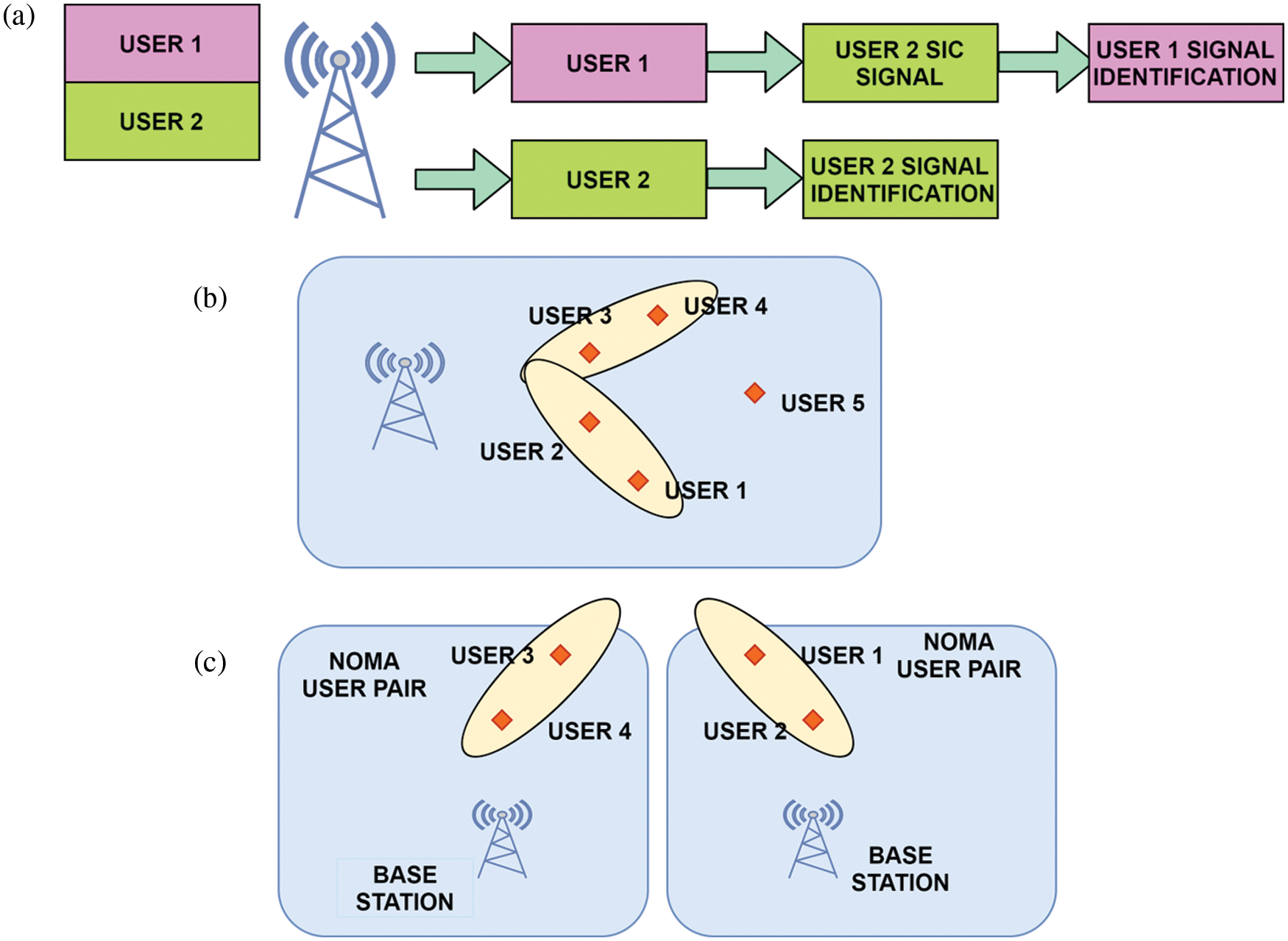
Figure 2: Illustrates the power domain of NOMA multiplexing: a) standard NOMA-SIC receiver; b) NOMA-MIMO systems; c) NOMA cellular network
3.2 Power-Domain Downlink NOMA
A primary NOMA network contains two different users with one BS, and every individual is provided with one antenna, as shown in Fig. 3. Assume x1 as well as x2 signals that the BS will send to user 1 and user 2 appropriately. The BS sends the coded superposition signal as

Figure 3: User power-domain downlink NOMA
Here
Here, hi denotes the channel gain among the user i and BS and ni denotes Gaussian noise, including interventions with the spectral density of power Nf,i. Inter-cell interference has been already incorporated in ni Multi-cell situation. At the receiver's side, SIC is utilized to segregate the signals of various users. The ideal decoding order of SIC is defined as |hi|2/Nf and is in descending sequence of the user's channels strengths. Every individual user can considerably reduce signals interference of other users if decoding commands occur after their own using this order. Thus result, user 1 contains the highest channel strengths
Without sacrificing flexibility, a user with poorer channel quality is given more power than a more robust channel quality to improve the signal-to-interference-plus-noise ratio (SINR). When user 1 executes SIC in the NOMA of 2-user with
The maximum total capacity that may be reached is
By adjusting the coefficients of power allocation α1 and α2, then

Figure 4: User downlink FDMA
In contrast to NOMA, as demonstrated by Formula (5) and then (6), neither OMA user suffers from signal interference of the other user.
An uplink NOMA system includes user 1, and user 2 sending their corresponding signals x1 as well as x2 to the BS at the same time. At the BS, the receiving signal is provided as
Pi denotes the i user's transmitting power E{|xi|2} = 1, n denotes the Gaussian noise in addition to the power spectral density interferences Nf. Generally, the BS transmits a reference downlink signal that each user uses to estimate the channel. As a result, based on the channel gains, users may set their system throughput to P1 or P2. Labeling user 1 as a more robust user with a more significant channel gain is more considerable than user 2 being labeled as the weaker user. The BS conducts SIC to distinguish the users’ signals after acquiring the superposed signal. Firstly user 1's signal is decoded by considering the signal of user 2 as noise. Subsequently, difference user 1's decoded signal
When SIC is ideal, the NOMA user's attainable data rate with a transmitting 1 Hz BW is as follows:
On contrasting (9) as well as (10) to its OMA equivalents, uplink NOMA could be demonstrated to be superior regarding attainable data rate along with total capacities, such as downlink NOMA. For a K-user uplink, NOMA having
Uplink NOMA unlike downlink NOMA, may support a higher number of users since BS can generally provide the necessary computational power and energy. Furthermore, BS can use more computationally demanding decoding techniques to decrease interference. As a result, uplink NOMA is superior to downlink NOMA for massive machine communication interaction.
Fig. 5 depicts Nb-IoT's architecture. The formation of control plane and user plane optimizations of EPC, Nb-IoT provides reduced the EPC architecture to enable the small information transfers necessary for M-IoT application areas. The eNodeB interacts with Nb-IoT devices or user apparatus, and then the eNodeB interacts with evolved packet core (EPC) IoT. The packet data networking and serving of GW, the plane entity of mobile management, and the Home Subscriber servers are all part of this. Afterward, eNodeB uses s1-lite to send the non-access stratum (NAS) to EPC. NAS protocol sends non-radio signals among Mobility Management Entity (MME) and then user device that provides session and movement management information. EPC searches for stratum to resume the procedure and further sends this to the IoT platform.

Figure 5: Nb-IoT architecture
The information is forwarded to application servers in a suitable format by the IoT system. The Application server subsequently processes the information. Information may be transferred among an Nb-IoT device and an application server in 2 directions, namely IP-based and non-IP-based. Transmitting Non-IP-based is highly favored because it minimizes the user overhead devices and is also efficiently secure because only single destination IP is authorized. For optimization signaling, Nb-IoT employs data over non-access stratum (DONAS) and radio resource control (RRC) suspending/resuming in addition to current RRC. DONAS allows users to send data without requiring a user account's activation and allows irregular data transfer. The RRC suspending/resuming process is a user plane improvement that offers a fast method to delete and reclaim the user plane.
Furthermore, Nb-IoT is intended for the transfer of intermittent and short messages between the device and the network. The gadget is thought to be capable of exchanging tiny messages over a single cell, eliminating the need for handoffs. Whether necessary, it must initially enter an idle state before restarting the cell selection procedure. Other EUTRA features like handover, Inter-RAT mobility, Channel Quality Indicator (CQI), and dual connectivity monitoring are not supported.
3.5 Deep Reinforcement Learning (DRL) for Quality-of-Service Enhancement
It is equipped to manage large-scale dynamic systems and enable energy-efficient service improvement for coordinating Nb-IoT networks. If the number of states actions in DRL is very big, DL could be utilized for functional value approximations, reducing memory and compute needs. Fig. 6 presents observable system states regarded as the networking input in the DQN for quality of service enhancement. It retrieves high-level characteristics from the inputs, and then the inputs pass via multiple networking layers with varied weights. Thereby, evaluates all potential actions in the last stage and generates a collection of Q-values as outcomes. It may speed up the learning procedure while simultaneously reducing the amount of memory required to store model variables. This is particularly essential for electronic devices featuring constrained capacities, including Internet of Things (IoT) devices.

Figure 6: DRL model for quality of service enhancement mechanisms
As a result, DRL is an excellent solution for various issues in systems and network communication, including resources development, non-convex and complicated issues, scheduling, etc. Furthermore, DRL may significantly reduce the model's complexity, mainly when it's utilized to solve various problems in future systems and networking communications. Mainly, the Q-learning algorithm is used in complicated and specialized settings, including communication networks, its performance suffers considerably. Thus, DRL may be utilized to better interact with high-dimensional state-space settings as functional approximations for the Q-function method. HetNets, ad-hoc, IoT, Unmanned Aerial Vehicle (UAV), and other communication methods and sectors may all benefit from DRL. Quality of service relates to a collection of techniques for controlling bandwidth, jitter, delay, and packet loss by evaluating several characteristics. Quality of service methods improves minimum one of those parameters. It has an indirect effect on the number of fundamental resources available on any network, and they're utilized to enhance the efficiency with which current resources are assigned to jobs. Specific techniques allow network management devices to deploy current network resources effectively, including bandwidth. With the growing number of linked smartphones and its volume of produced traffic, Quality of Service (QoS) is now a critical tool for dealing with the expanded number and services diversity. ISPs sell Quality of Service (QoS) in two ways: explicitly (as a choice) and implicitly (as part of a service). For various services, like phone, data, multimedia, ISPs guarantee a specific degree of performance. To do so, they must consider a variety of QoS-related parameters, such as loss rate, end-to-end latency, and dependability.
Quality of service mechanism is broadly classified into two major groups: (1) resource management and (2) traffic handling. The latter relates to processes and approaches in the MAC layer, which try to manage networking resources, such as radio resources, by configuring and coordinating network elements such as User Equipment (UE), BS, and Access Points (AP). The two primary techniques for bandwidth management are admission controlling and resource reserves. Such techniques describe the procedures that maximize network transmission at heavy traffic flow conditions. It can flow four necessary traffic handling capabilities: classification, channel access, traffic policing, and packet planning. The primary DRL-based features in the MAC layer that enable quality of service are divided into 2 classifications: network accessing and data rate-controlling and resource distribution and planning.
This section analyzes the results of the proposed Deep reinforcement learning-based Software-defined air interface switching algorithm for the QoS enhancement mechanism of 5G/6G Nb-IoT mobile networks. Concentrating on the current frequency range with extremely broad bandwidths will shift the focus away from optimized solutions spectrally and toward systems with enhanced coverage. In this new frequency spectrum, proper balancing among power efficiency, spectrum performance, and coverage would be critical in designing devices in such a new spectrum frequency. This will contribute to developing a modern air interface in which single-carrier systems are more concerned. The OFDM system will be reviewed for a relatively low-frequency range wherein spectral efficiency is essential. The cyclic prefix that is merely a duplicate of data but does not store any more data is not using energy efficiently.
Moreover, power amplifiers with a higher peak-to-average power ratio (PAPR) are complicated and costly. As a result, Deep Reinforcement Learning and NOMA have emerged as potential new approaches for 5G/6G network communications. In NOMA, every user has accessibility to the entire frequency band resource simultaneously. As an intelligent air interface for quality of service user enhancement, a novel software-defined air interface depending on the AI is presented. Multiple waveform arrangements and two frequency sets are described in release 15 3GPP that provides the requirements for 5G-New Radios (NR). The software-defined intelligence air interface is used to accomplish the suggested quality of service based on consumers’ Deep Reinforcement learning increase. Small scale networks in 5G will also employ NOMA methods to enhance access efficacy by enabling several users to utilize the identical spectrum frequencies in a non-orthogonal fashion. NOMA introduces considerable co-channel interference between mobile users, posing central structure and resource network management problems. As a result, the resources are given in response to user requests for coordinated Nb-IoT networks. The core NOMA taxonomy is given by concentrating on the resource usage classifications of code-domain NOMA and power domain.
Furthermore, for uplink and downlink broadcasts, a new radio resource system based on Deep Reinforcement Learning is given. Lastly, possible applicability and open scientific areas for NOMA in resource management have been discussed. Fig. 7 shows the number of planned users vs. the total number of CD-NOMA network users. Fig. 8a shows the data rate areas of downlink NOMA as well as OMA by displaying a data rate of a user against the data rate of another user at various ratios of power allocation with h1 = 10 and h2 = 1. As can be seen, the rate range of NOMA is significantly more extensive than that of OMA. Fig. 8b depicts the combined capacity of two-user downlink NOMA and OMA.
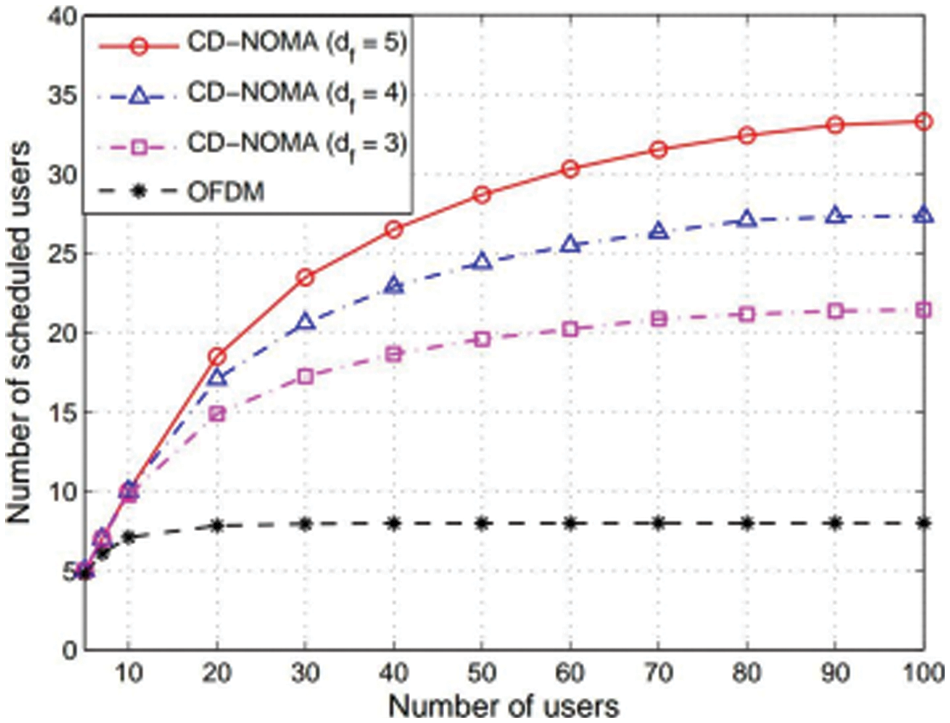
Figure 7: Number of scheduled users vs. a number of users in a CD-NOMA network
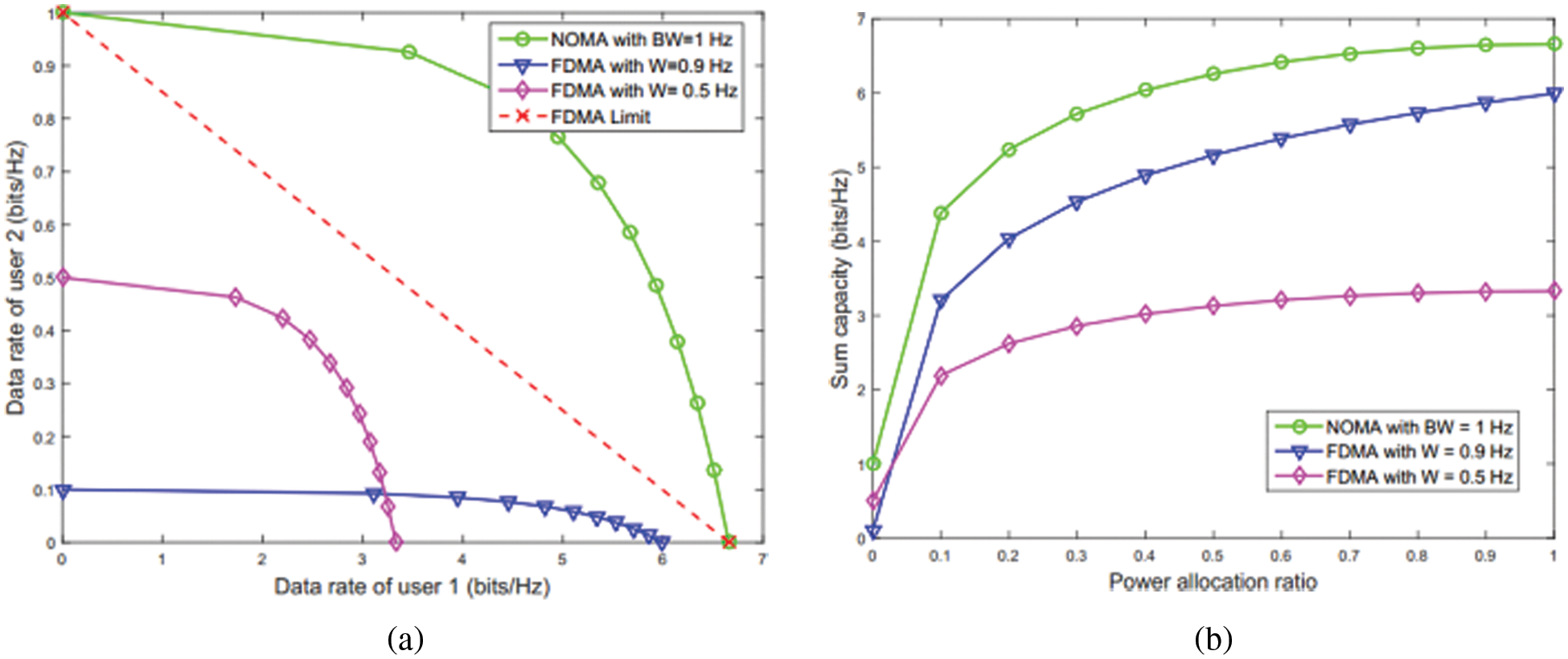
Figure 8: Comparison of 2-user downlink NOMA with OMA (a) Rate region, (b) Sum capacity
Fig. 9 shows that the quality of service enhancement is examined with the two users using the proposed Deep Reinforcement learning strategy for the Nb-IoT network. First, consider two users with equal distance from the base station. In this case, NOMA achieves higher rate pairs than the OFDMA. But at this point, both the NOMA and OFDMA meet with the same capacity range, only when the SNR values of the two users are the same. There implies NOMA is more efficient than OFDMA. It is clearly shown in Fig. 9a.
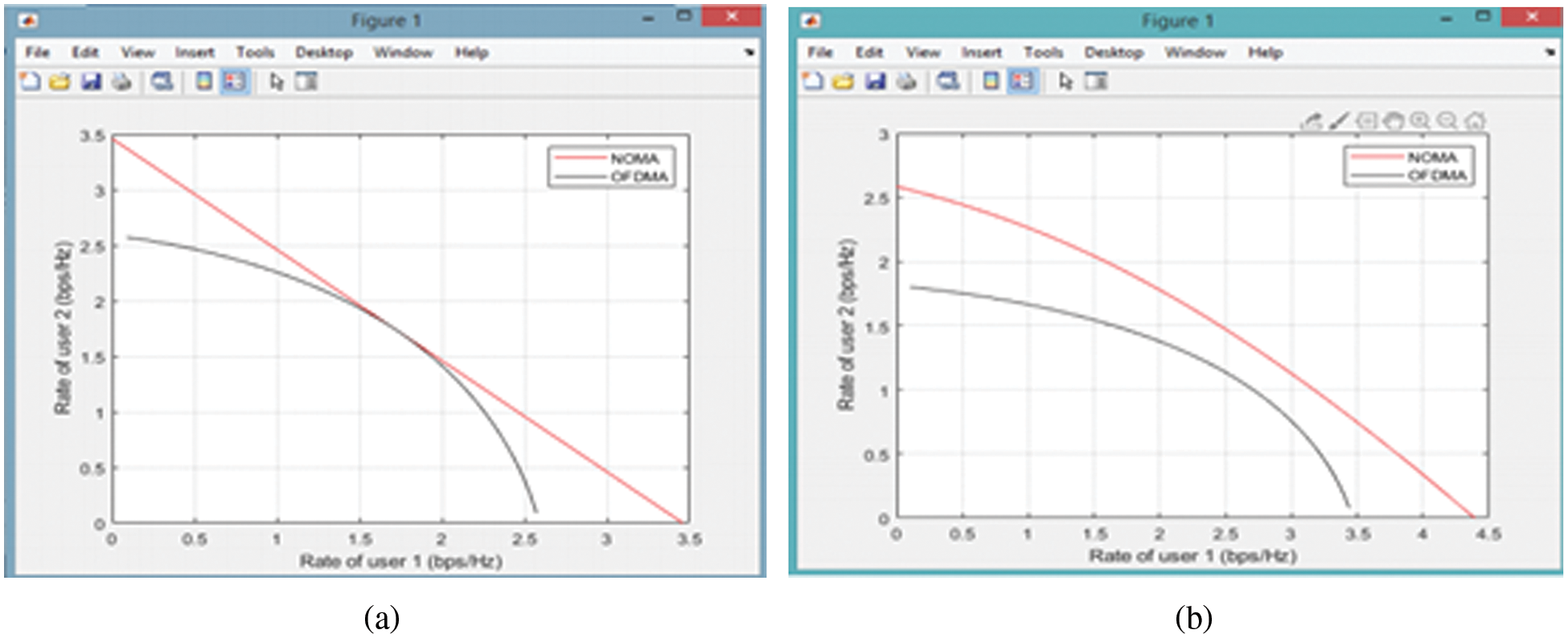
Figure 9: Quality of service enhancement is examined at the downlink of two users (a) sum capacity of SNR1 = SNR2 (b) sum capacity with SNR1 not equal to SNR2
Similarly, consider two users but with different distances from the base station. In this case, NOMA achieves higher rate pairs than the OFDMA. But it does not meet with same capacity range because the SNR values of the two users are different. So, NOMA is more efficient than OFDMA. Downlink Sum capacity is shown in Fig. 8b. Anyhow, the energy and Spectrum efficiency are inversely proportional to each other in the above two cases. If Energy efficiency (EE) increases, Spectrum efficiency (SE) decreases, and if Spectrum efficiency increases, Energy efficiency decreases. The peak of the curve is where the system has the maximum energy efficiency. The energy efficiency and spectrum efficiency relationship is linear with a positive slope of
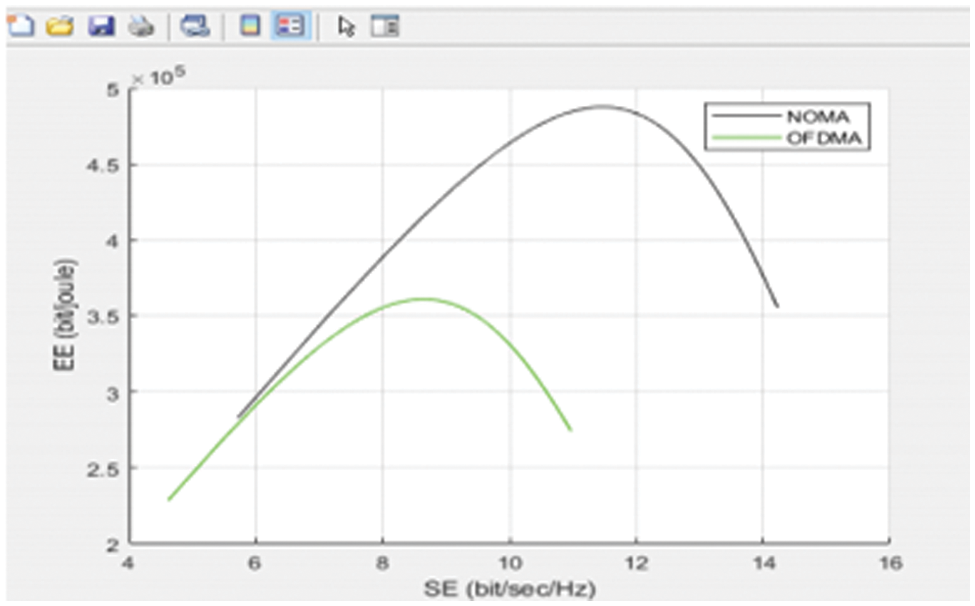
Figure 10: Comparison of energy efficiency and spectral efficiency
The comparison of 2 users’ SNR with a codeword for 8 and 14 db in the cluster form as receiver constellation, as shown in Fig. 11. It demonstrates that when the SNR value is high receiver can differentiate noise and signal, but when the SNR value is decreased, it can't differentiate among them. Here we compared the two users with SNR values variation by increasing the SNR value among the users-user 2 has less noise, which is clearly shown, so user 2's is highly beneficial. The received constellation SNR of 2 Users is shown in Figs. 10a and 10b. On the other hand, the proposed DRL method examines the QoS parameter under throughput of NOMA for 2 users, as shown in Fig. 12. As the constellation simulation user 2 has less noise, it is more efficient than user 1. So, user 2 has high throughput than user 1. User's noise level is less, which leads to better data transmission. It is done by codeword generation in the transmitter to send the data to its receiver.
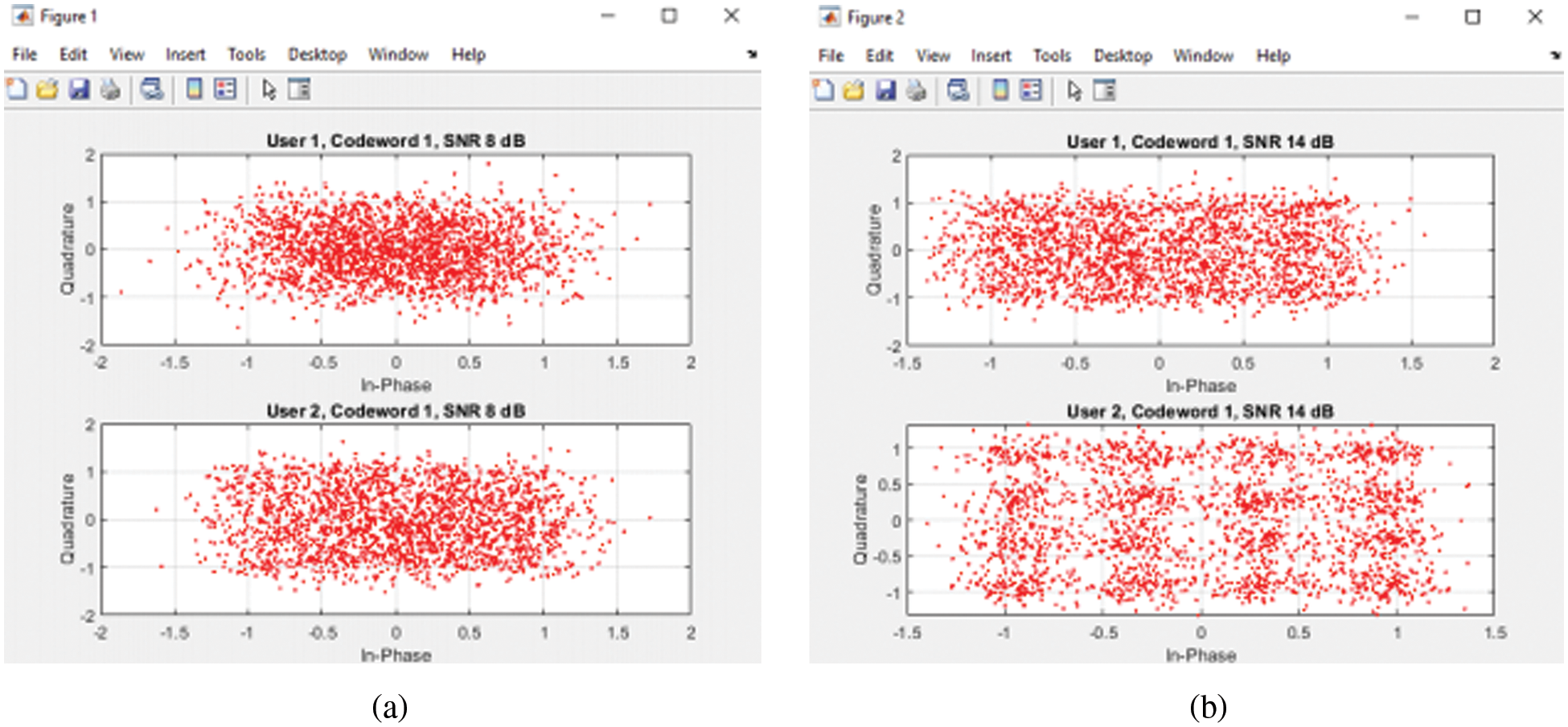
Figure 11: Received constellation SNR of 2 users (a) 8 dB, (b) 14 dB
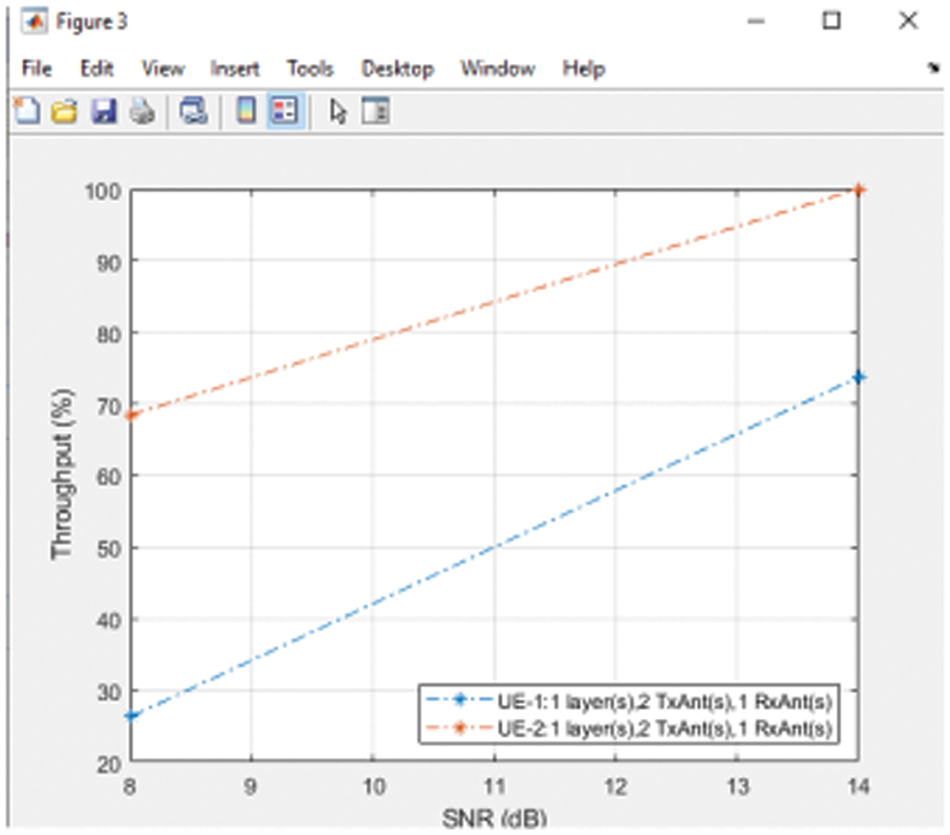
Figure 12: Simulated graph of throughput of 2 users using MIMO-NOMA
This paper proposes a deep reinforcement learning (DRL) based software-defined air interface algorithm applied on the switching system that satisfies the user requirement and enables them with the network resources to extend quality of service by choosing the most appropriate quality of service metric. Nb-IoT networks, DRL-based quality of service improvement methods, and NOMA approach are expected to be potential technologies for forthcoming 5G networks communication systems that offer enormous connection and lower latency. We have demonstrated that the traditional OFDMA outperforms in terms of total sum capacity, spectral efficiency, as well as energy efficiency. This happened because a unique codeword is generated for each transmission, so data can be sent to its receiver without scattering or lost by its transmitter. Thus, constitutes one of the promising solutions to signal interference for future 5G systems. It is possible only when the transmitter has easily differentiated the noise and signal it can be executed by increasing the SNR value. As higher the SNR value, the transmission will be better. By this, the throughput will also be very efficient. Since LTE has become the most used network due to reduced interference even though the users are more, it has been implemented to improve the efficient usage of limited network resources and influence high in LTE due to more users. Furthermore, it provides effectiveness on the rise in SNR value, and their transmission will be good, resulting in highly efficient throughput.
Funding Statement: The authors received no specific funding for this study.
Conflicts of Interest: The authors declare that they have no conflicts of interest to report regarding the present study.
1. E. Jimeno, J. Pérez-Romero, I. V. Muñoz, B. Blanco, A. Sanchoyerto et al., “5G framework for automated network adaptation in mission critical services,” in 2018 IEEE Conf. on Network Function Virtualization and Software Defined Networks (NFV-SDN), Verona, Italy, pp. 1–5, 2018. [Google Scholar]
2. D. Mishra, A. Khan, R. Tiwari and S. Upadhay, “Automated irrigation system-IoT based approach,” in 2018 3rd Int. Conf. on Internet of Things: Smart Innovation and Usages (IoT-SIU), Bhimtal, India, pp. 1–4, 2018. [Google Scholar]
3. T. Kaur and D. Kumar, “Qos mechanisms for MAC protocols in wireless sensor networks: A survey,” IET Communication, vol. 13, no. 14, pp. 2045–2062, 2019. [Google Scholar]
4. A. Ayyasamy and K. Venkatachalapathy, “Context aware adaptive fuzzy based qos routing scheme for streaming services over MANETs,” Wireless Networks, vol. 21, no. 2, pp. 421–430, 2015. [Google Scholar]
5. J. Gubbi, R. Buyya, S. Marusic and M. Palaniswami, “Internet of things (IOTA vision, architectural elements, and future directions,” Future Generation Computer Systems, vol. 29, no. 7, pp. 1645–1660, 2013. [Google Scholar]
6. E. Borgia, “The internet of things vision: Key features, applications and open issues,” Computer Communications, vol. 54, pp. 1–31, 2014. [Google Scholar]
7. C. Liang, S. Thombre, K. Jarvinen, E. S. Lohan and H. Kuusniemi, “Robustness, security and privacy in location-based services for future iot: A survey,” IEEE Access, vol. 5, no. 99, pp. 8956–8977, 2017. [Google Scholar]
8. C. Brewster, I. Roussaki, N. Kalatzis, K. Doolin and K. Ellis, “Iot in agriculture: Designing a Europe-wide large-scale pilot,” IEEE Communications Magazine, vol. 55, no. 9, pp. 26–33, 2017. [Google Scholar]
9. T. Ninikrishna, S. Sarkar, R. Tengshe, M. K. Jha, L. Sharma et al., “Software defined iot: Issues and challenges,” in 2017 Int. Conf. on Computing Methodologies and Communication (ICCMC), Erode, India, pp. 723–726, 2017. [Google Scholar]
10. Mourad, A., R. Yang, P. H. Lehne and A. D. L. Oliva, “A baseline roadmap for advanced wireless research beyond 5G,” Electronics, vol. 9, no. 2, pp. 351, 2020. [Google Scholar]
11. G. Min, H. Jia and M. E. Woodward, “Performance modelling and analysis of the txop scheme in wireless multimedia networks with heterogeneous stations,” IEEE Transactions on Wireless Communications, vol. 10, no. 12, pp. 4130–4139, 2011. [Google Scholar]
12. F. Tang, B. Mao, Z. M. Fadlullah and N. Kato, “On a novel deeplearning-based intelligent partially overlapping channel assignment in sdn-iot,” IEEE Communications Magazine, vol. 56, no. 9, pp. 80–86, 2018. [Google Scholar]
13. A. Rostami, P. Ohlen, K. Wang, Z. Ghebretensae, B. SkubicVidal et al., “Orchestration of ran and transport networks for 5 g: An sdn approach,” IEEE Communications Magazine, vol. 55, no. 4, pp. 64–70, 2017. [Google Scholar]
14. Z. Qin, G. Denker, C. Giannelli, P. Bellavista and N. Venkatasubramanian, “A software defined networking architecture for the internet-of things,” in Network Operations and Management Symp., Krakow, Poland, pp. 1–9, 2014. [Google Scholar]
15. K. Kalkan and S. Zeadally, “Securing internet of things (iot) with software defined networking (SDN),” IEEE Communications Magazine, vol. PP, no. 99, pp. 1–7, 2017. [Google Scholar]
16. A. Rico-Alvarino, M. Vajapeyam, H. Xu, X. Wang, Y. Blankenship et al., “An overview of 3GPP enhancements on machine-to-machine communications,” IEEE Communications Magazine, vol. 54, no. 6, pp. 14–21, 2016. [Google Scholar]
17. S. Agnes, “Intel, Nokia and Ericsson collaborate on NB-LTE wireless for IoT,” in Capacity Magazine, Helsinki, Finland: Telecoms, Tech. Rep. 915, pp. 1–5, 2015. [Google Scholar]
18. Y. -P. -E. Wang, X. Lin, A. Adhikary, A. Grovlen, Y. Sui et al., “A primer on 3GPP narrowband internet of things,” IEEE Communications Magazine, vol. 55, no. 3, pp. 117–123, 2017. [Google Scholar]
19. T. T .Leonid and R. Jayaparvathy, “Classification of elephant sounds using parallel convolutional neural network,” Intelligent Automation & Soft Computing, vol. 32, no. 3, pp.1415–1426, 2022. [Google Scholar]
20. Q. Song, S. Guo, X. Liu and Y. Yang, “CSI amplitude fingerprinting based Nb-IoT indoor localization,” IEEE Internet Things J, vol. 5, no. 3, pp. 1494–1504, 2017. [Google Scholar]
21. X. Lin, “Positioning for the internet of things: A 3GPP perspective,” IEEE Communications Magazine, vol. 55, no. 12, pp. 179–185, 2017. [Google Scholar]
22. R. Ratasuk, B. Vejlgaard, N. Mangalvedhe and A. Ghosh, “Nb-IoT system for M2M communication,” in Proc. IEEE Wireless Communication Networks Conf., Doha, Qatar, pp. 428–432, 2016. [Google Scholar]
23. T. Inoue and D. Vye, “Simulation speeds Nb-IoT product development,” Microchemical Journal, vol. 60, no. 12, pp. 82–92, 2017. [Google Scholar]
24. N. Saha, S. Bera and S. Misra, “Sway: Traffic-aware qos routing in software-defined iot,” IEEE Transactions on Emerging Topics in Computing, vol. PP, no. 99, pp. 1, 2018. [Google Scholar]
25. G. C. Deng and K. Wang, “An application-aware qos routing algorithm for sdn-based iot networking,” in 2018 IEEE Symp. on Computers and Communications (ISCC), Natal, Brazil, 2018. [Google Scholar]
26. Z. Qin, G. Denker, C. Giannelli, P. Bellavista and N. Venkatasubramanian, “A software defined networking architecture for the internet-of-things,” in Network Operations and Management Symp., Krakow, Poland, pp. 1–9, 2014. [Google Scholar]
27. J. M. Llopis, J. Pieczerak and T. Janaszka, “Minimizing latency of critical traffic through SDN,” in 2016 IEEE Int. Conf. on Networking, Architecture and Storage (NAS), Long Beach, CA, USA, pp. 1–6, 2016. [Google Scholar]
28. Y. Siriwardhana, P. Porambage, M. Liyanage and M. Ylianttila, “AI and 6G security: Opportunities and challenges,” in 2021 Joint European Conf. on Networks and Communications & 6G Summit (EuCNC/6G Summit), Porto, Portugal, pp. 616–621, 2021. [Google Scholar]
 | This work is licensed under a Creative Commons Attribution 4.0 International License, which permits unrestricted use, distribution, and reproduction in any medium, provided the original work is properly cited. |